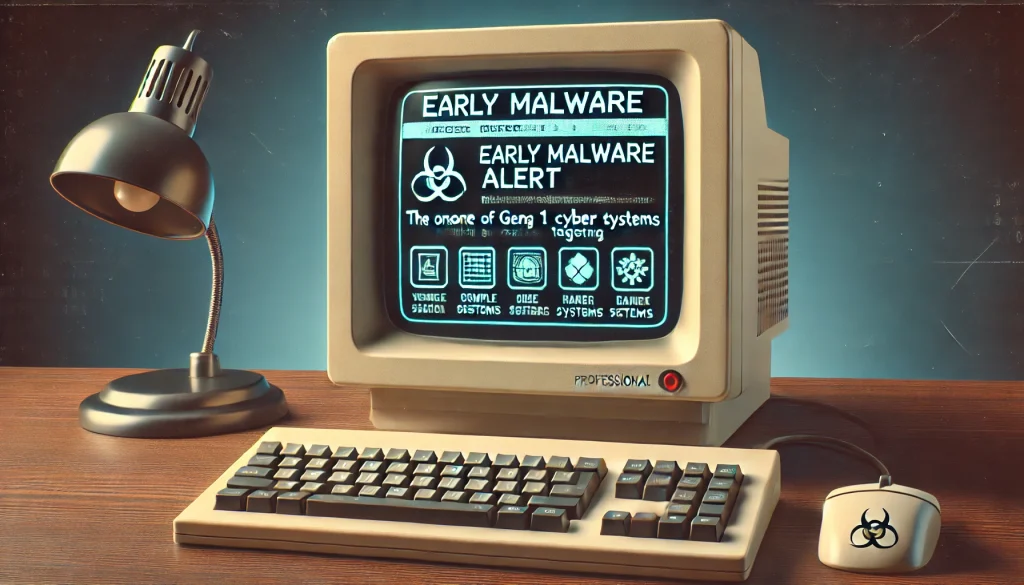
In the fast-evolving world of cybersecurity, understanding the history and evolution of cyber attacks is crucial. While modern attacks are sophisticated, they all trace back to the foundational wave known as Gen 1 Cyber Attacks. These early threats were less complex but set the stage for the intricate cybersecurity challenges we face today. With the rise of malware, viruses like Elk Cloner, and sneaker-net spreading methods, businesses and individuals faced unprecedented risks. This October 2024, it is essential to revisit the origins of cyber threats to understand how we got here and what we need to do to stay safe.
Overview
Cybersecurity has evolved significantly since the 1980s, but it all began with Gen 1 Cyber Attacks. This era introduced the first digital threats, which, though basic by today’s standards, were groundbreaking at the time. Gen 1 attacks, primarily involving viruses and worms, exploited simple vulnerabilities in individual computers. These early threats were spread via “sneaker-net,” where malicious software was physically transferred through media like floppy disks from one device to another.
This period was pivotal in shaping how businesses and individuals approached security. Viruses like Elk Cloner, the first to spread “in the wild,” highlighted the importance of protecting digital assets. Although Gen 1 attacks may seem primitive compared to today’s complex ransomware and zero-day exploits, their legacy laid the foundation for modern cybersecurity strategies. They prompted the early adoption of antivirus software, awareness of digital threats, and the development of preventive measures that continue to evolve with today’s sophisticated landscape.
How it Works?
At the heart of Gen 1 cyber attacks were simple yet effective viruses and worms. Unlike today’s multi-layered threats, these attacks were relatively unsophisticated. They often involved malicious code embedded in software or documents, designed to replicate and spread through a computer system. The major distribution method was via sneaker-net—physically transferring infected media like floppy disks between machines. This method of attack was prevalent when networks were sparse, and direct computer-to-computer communication was limited.
One of the most notorious early examples was Elk Cloner, a virus that spread through Apple II computers in 1982. It was innocuous by today’s standards, causing no permanent harm, but it was the first virus to demonstrate the potential for widespread infection.
Though less intricate, these attacks were the foundation for what was to come. They taught developers and users alike the value of patching software and the importance of user awareness in combating digital threats.
Examples

1. Elk Cloner
One of the key examples of Gen 1 cyber attacks is the Elk Cloner virus. Created by a teenager as more of a prank than a malicious act, Elk Cloner was notable for being the first virus to spread beyond its origin, infecting thousands of machines via infected floppy disks. Once the virus activated after the 50th boot, it displayed a playful poem but did no actual damage to the host computer. Nevertheless, its ability to self-replicate and spread marked the beginning of a new era in digital threats.
2. Brain Virus
Another example is the Brain Virus, which appeared in 1986. It targeted the boot sector of MS-DOS systems, and like Elk Cloner, spread via floppy disks. The virus displayed a message asking the user to contact the creators for removal. Again, the virus didn’t cause significant damage but made its mark by showing the vulnerabilities present in systems that lacked robust security measures.
Impact on Businesses
The early impact of Gen 1 cyber attacks on businesses was significant, even though the attacks were relatively simple. In the 1980s and 1990s, companies were just beginning to digitize their operations, making them ill-prepared for threats like the Elk Cloner and Brain Virus. These early viruses, while not as financially devastating as modern ransomware or hacking campaigns, exposed critical vulnerabilities and forced businesses to rethink their approach to security.
Even though these attacks didn’t involve mass data theft or destruction, the downtime they caused was costly. Restoring or manually cleaning infected systems disrupted operations, prompting businesses to invest in antivirus software, employee training, and network protection. These incidents also underscored the ease with which viruses could spread via infected media, leading companies to establish stricter controls over data handling and device usage, especially as employees frequently transferred information across physical devices.
Ultimately, these early cyber threats set a precedent, pushing businesses to recognize the importance of safeguarding digital assets and establishing the foundational cybersecurity practices still relevant today.
Prevention Measures

The first line of defense against Gen 1 cyber attacks was, and still is, awareness. In the early days, simply recognizing that viruses could spread through physical means like floppy disks was a breakthrough. As businesses became aware, they adopted basic precautions, such as scanning disks and being cautious about software sources.
While Gen 1-style attacks have become nearly obsolete due to advances in network security and cloud computing, the core lessons remain relevant. Practices like updating software, avoiding suspicious downloads, and maintaining regular backups are just as critical now as they were in the 1980s.
The companies affected by the first wave of cyber attacks helped shape modern cybersecurity strategies, including the adoption of antivirus programs and the development of early firewalls. These foundational steps continue to influence today’s defense tactics.
The Future
While we are far removed from the Gen 1 era, its legacy continues to shape our current approach to cybersecurity. Many of the prevention measures that were adopted in the wake of early viruses remain relevant today, though they have evolved considerably. For example, antivirus software that once merely scanned for known threats has now developed into sophisticated threat detection systems using artificial intelligence and machine learning.
Looking forward, businesses will need to keep adapting as threats evolve. Although Gen 1 cyber attacks may seem outdated, the ever-changing nature of cybercrime means that even the oldest tactics can be adapted for new uses. Attackers may modify social engineering or older virus deployment strategies to exploit overlooked vulnerabilities in modern systems.
Conclusion
Understanding the history of Gen 1 cyber attacks provides crucial insights into the evolution of modern cyber threats. In the early 1980s, digital viruses like Elk Cloner emerged, spreading through methods like sneaker-net. Though basic by today’s standards, these early viruses caused enough disruption to make businesses and individuals rethink security strategies, laying the groundwork for modern cybersecurity.
While today’s cyber landscape is far more complex, foundational lessons from these early attacks still hold value. Prevention techniques such as updating software, maintaining backups, and exercising caution with unknown files remain vital. Looking ahead, it’s evident that while attack methods will evolve, the need for strong cybersecurity measures will only intensify.
Key Takeaways
- Gen 1 cyber attacks were the first significant wave of digital threats, primarily spread through physical media like floppy disks.
- Early viruses like Elk Cloner and the Brain Virus set the stage for future cybersecurity strategies, emphasizing the importance of awareness and prevention.
- Although technology has evolved, many of the principles for preventing Gen 1 attacks are still applicable today, such as maintaining updated software and practicing caution with unfamiliar files.
Resources
Cybermagazine. The Evolution of Cybersecurity.
Katz. The Evolution of Cyber Threats.
Roboticsbiz. Five Generations of Cyber Attacks in History.
Knowbe4. Five Generations of Cybercrime.
Check Poinr. Preventing the Next Mega Cyber Attack.
